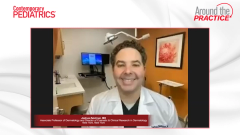
Pharmacological Options for the Treatment of Pediatric Atopic Dermatitis
Experts treating pediatric atopic dermatitis discuss the pharmacological options for the treatment of pediatric atopic dermatitis.
Episodes in this series

Joshua Zeichner, MD: For our last question, I want to focus on therapy. Let’s review the options we have for mild to moderate atopic dermatitis [AD], in terms of topicals and systemic medications. Vikash, lead this off for us. Take us through the topical options in terms of emollients or moisturizers and prescription options.
Vikash Oza, MD: In terms of prescription options, our true standby is still topical steroids. Although we have all these newer therapies, topical steroids are still effective for addressing acute flares. Many times, they can be cheaper in our health care system, and they play a large role in getting through a flare. A lot of times, patients struggle with the maintenance of the chronic aspect of their disease, especially the patients who come to see us. Most patients who see a specialist often have moderate to severe disease and need a maintenance therapy. That’s where we’re leaning toward potentially nonsteroid options.
Depending on your age, you have different FDA-approved options. For infants aged 3 months and older, we have crisaborole, or Eucrisa. For children aged 2 years and older, we have tacrolimus 0.03% and pimecrolimus. For patients aged 16 and older, we have tacrolimus 0.1%. Our newest agent for patients aged 12 and older is topical ruxolitinib. We’re starting to incorporate these therapies as maintenance of disease, getting someone through a flare but having a therapy that we feel you can use on an intermittent basis to maintain your disease control if you don’t fall into that threshold of having a systemic disease.
As Raj brought up at the start, the second pillar is skin care. It’s interesting that we have these directed therapies. With our skin care, we still don’t have directed therapies for their specific barrier problem because there’s probably a lot of variability. But a lot of what we have over the market are ceramide-enriched emollients, which are important as the mainstay. We have literature showing that appropriate use of an emollient 2 to 3 times a day can potentially reduce the frequency of flares. They’re important.
From a clinician standpoint, 1 thing I’ve de-emphasized a little over time in my first visit with a patient with atopic dermatitis, when we’re trying to get them under control and out of a flare, is to focus on prescription therapies in those first several weeks because they’ve already exhausted everything that their pharmacy has to offer from emollients. Gentle skin care is clearly important, but getting them to the point where they’re over this hump of inflammation, where maintaining their skin barrier can help as a preventive way of reducing flares, is conceptually a construct that I help guide them through.
Joshua Zeichner, MD: Brit, let’s have you close this out for us. Take us through some of the traditional systemic medications and newer biologics that we have for atopic dermatitis.
Brittany Craiglow, MD: Fortunately, this conversation has changed a lot, even in the past several years. Before targeted therapy, we were using a lot more chronic topicals and having patients who are teetering have their parents or themselves do a lot of work at home just to keep them OK, including wet wraps and all these things; it’s like a full-time job. There are data that caregivers spend about 22 hours a week with their child with atopic dermatitis. We accepted that before because our options were these things that had a decent amount of risk associated with them. It was more traditional immunosuppressants, like cyclosporine, mycophenolate, and methotrexate. We would pull the trigger on those. But at least for me, I waited until I felt like it was so bad that I could justify the risk and put the patient through blood draws and have a conversation about risk for malignancy and infection, etc.
Having more targeted therapies has made me realize that I was tolerating a level of disease that I probably shouldn’t have been because the options weren’t that great. We have those more broadly acting traditional immunosuppressants. There are oral corticosteroids. That almost never happens in my clinic unless I’m bridging somebody to something else, because we know those are a Band-Aid. They’re a short-term solution. Unfortunately, a lot of patients are still given chronic oral steroids—they’re going to see someone who’s giving them intramuscular triamcinolone every few months, and we can’t underestimate the risk of that long term. I’ve seen patients with osteopenia from chronic oral steroids for their atopic dermatitis. We need to move beyond that. We don’t have to do that now at all.
With dupilumab, it was a major breakthrough to have a targeted therapy without talking about a black-box warning or doing blood draws. Now we have approval down to the age of 6 months. If anything speaks to safety, even in our adult patients, it’s that. Having dupilumab in my toolbox has enabled me to pull the trigger earlier on patients and impact their quality of life in a huge way. Earlier, there was the point made about how people don’t even how bad it is. That’s because they’ve always been like this. With psoriasis, people come in and say, “What is this? Make it go away,” or someone has 5% body surface area and you say, “You need a biologic.” That’s because they had normal skin and then they got psoriasis and they want to go back to who they were before. But with AD, they don’t know any different. We have to help people understand it. “Now there is something. I know things haven’t worked for you in the past, or there were scary adverse effects. But now we have options.”
Following dupilumab, we have tralokinumab inhibiting IL-13, and we’ve recently had 2 oral JAK inhibitors approved, with upadacitinib for patients aged 12 and up and abrocitinib for patients aged 18 and up. Those therapies can be very effective and work quickly on itch, but in my mind and by their labels, they’re in the second line after a biologic like dupilumab. That’s more of a conversation because they’re acting intracellularly and more cytokines are floating through there. There’s more discussion about adverse effects and risk. But it’s amazing for patients, because although many people will do well with dupilumab, there are going to be some people for whom it isn’t completely effective. For them we now have an option if they’re aged 12 or older. But we’re going to see trials in younger populations too.
This is a disease that people aren’t going to have to live with. It has taken a while, but we’re going to be where we are with psoriasis very soon. What’s cool is we’ve started with a super-targeted, great safety profile compared with what we’ve had to do with biologics in psoriasis.
Joshua Zeichner, MD: As we look at the total population of patients, in many ways, it’s an easy decision on how to treat mild patients and severe patients. Even before we had the more targeted therapies, it was worth the risk to get a benefit for severe patients. But the people who had the most unmet need were the moderate patients. These were people to whom I’d personally give a tub of triamcinolone. It was doing OK, but they weren’t quite bad enough in my mind to justify a systemic immunosuppressant medication, such as cyclosporine. But now we have targeted biologics that address IL-4 and IL-13 and have such a great safety profile—there’s a systemic agent that can change the lives of these moderate patients in whom previously I wouldn’t even have considered a systemic medication. In my practice, it’s a home run across the board, especially for those moderate patients.
Brittany Craiglow, MD: Some of those patients are the most grateful, such as the person who isn’t erythrodermic but is just never clear. They can’t go on vacation without their triamcinolone. Everything is greasy. They get a new life afterward. We’re talking about therapies that have a great adverse effect profile. We shouldn’t be waiting on those people. If they come in and are on 3 different prescriptions, and they’re having to use 1 on this day and another on another day and they can’t keep track, and they’re waking up scratching, then we need to move on and treat them more appropriately.
Joshua Zeichner, MD: For everybody listening to this, my message is to remember that the full indication for these systemic biologics is moderate to severe. Don’t forget about those moderates, where we can make a huge impact on quality of life.
Transcript Edited for Clarity
Newsletter
Access practical, evidence-based guidance to support better care for our youngest patients. Join our email list for the latest clinical updates.











